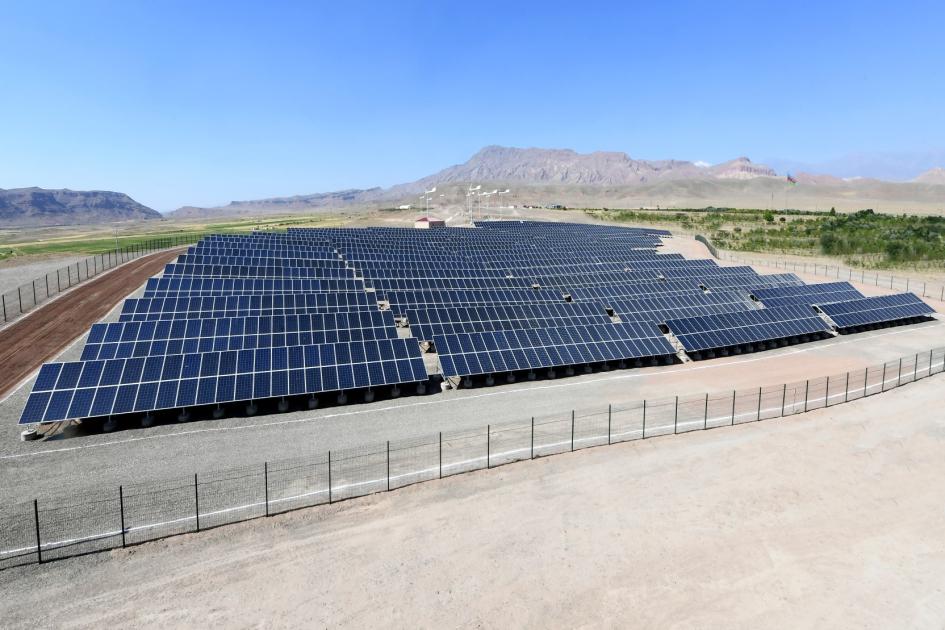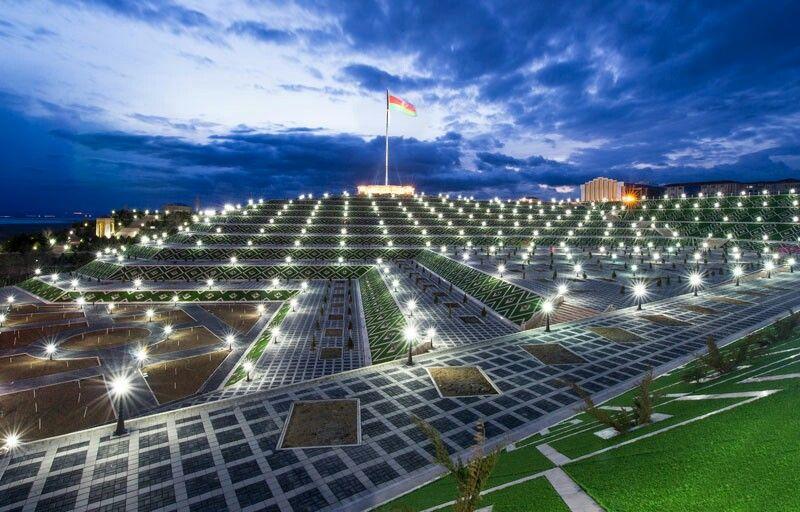Azerbaijan's Nakhchivan draws foreign investors with unique geographical advantage Advancing towards green energy exports
The work has been underway in the Nakhchivan Autonomous Republic to develop industry and modernise infrastructure for over two years as part of large-scale reforms.
One of the goals of these transformations is the development of the Nakhchivan Autonomous Republic’s power sector. The generation capacity is planned to be increased mainly through renewable energy sources and export of goods is planned to be established to Türkiye.
These initiatives are being successfully implemented. According to the data from the State Energy Service of the Nakhchivan Autonomous Republic published on July 8, the share of green energy in the total generation of the Nakhchivan Autonomous Republic exceeded 70 per cent. According to this indicator, the Nakhchivan Autonomous Republic holds not only the first place in Azerbaijan, but is also ahead of many advanced European countries with developed “green” energy.
The first large-scale project of developing Nakhchivan’s hydropotential was implemented in 1971 during the period of the Union of Soviet Socialist Republics. Together with Iran, the Araz hydroelectric complex and a dam hydroelectric power station with a capacity of 22 MW, located on the section of the border river Araz in the Nakhchivan Autonomous Republic, were put into operation.
After the collapse of the Union of Soviet Socialist Republics, the Nakhchivan Autonomous Republic, which was under an energy blockade for many years, due to objective conditions, was forced to greatly increase the share of alternative energy. The Nakhchivan Autonomous Republic provided about half of the total electricity consumption due to the commissioning of various dam and diversion hydroelectric power stations. Today, there are five small and medium-sized hydroelectric power stations in the Nakhchivan Autonomous Republic, as well as two solar power plants in the Babak and Julfa districts.
This trend was further developed taking into account the detailed action plan approved in 2023 by the Cabinet of Ministers within the “State Programme for the Socio-Economic Development of the Nakhchivan Autonomous Republic for 2023–2027”. Thus, the Cabinet of Ministers’ plan for 2024 has stipulated the continuation of the construction of the Ordubad hydroelectric power station with a capacity of 36 MW and the Tivi hydroelectric power station with a capacity of 15.6 MW to further develop the hydropower potential of the Nakhchivan Autonomous Republic.
The water supply system of the Bilav hydroelectric power station is planned to be overhauled in 2023–2024. The oldest hydroelectric power station in the region - the Araz hydroelectric power station is planned to be reconstructed and the Nakhchivan modular power plant with a capacity of 87 MW is planned to be overhauled in 2023–2024.
According to the State Energy Service of the Nakhchivan Autonomous Republic, the total capacity of power plants included in this structure is 244.8 MW, and is mostly represented by “green” generation facilities. During the periods of high river flow and maximum electricity generation at hydroelectric power stations, alternative energy accounts for over 90 per cent of all electricity production.
Moreover, for the first time, for three days in mid-April 2024, the energy supply in the Nakhchivan Autonomous Republic was almost fully provided through renewable energy. However, electricity generation in the renewable energy sector (including solar panels) remains at a very high level even in the hot summer period in case of a decrease in river flows and reservoir levels. Thus, according to the State Energy Service, 70.4 per cent of the total volume of electricity produced in the Nakhchivan Autonomous Republic accounted for alternative sources in June 2024.

Is it a lot or a little? It is significant when compared with the general situation in Azerbaijan, where by the end of last year the capacity of renewable energy sources in the energy system was estimated at about 1,700 MW, and their share in total generation reached 20 per cent. Moreover, the green energy reserve in the Nakhchivan Autonomous Republic looks more than impressive even when compared with developed European countries that have achieved obvious success in the development of alternative energy.
For comparison, the share of renewable energy generation in the total electricity system of Germany and Spain reached 50 per cent by the end of last year, this figure was 42 per cent in the UK, 40 per cent in Denmark, 37 per cent in Switzerland, 35 per cent in Finland, 27 per cent in Sweden. Thus, even in summer, when energy production at the Nakhchivan Autonomous Republic’s hydroelectric stations is not so high, the indicators of green energy generation in Nakhchivan are comparable to the leading European country - Norway, where there are over 1,000 reservoirs, dozens of mountain rivers, and over 1,660 hydroelectric power stations with a total capacity of 34,813 MW. Norway today provides 70 per cent of annual electricity consumption in the renewable energy segment due to its powerful hydro potential. Of course, when comparing the Nakhchivan Autonomous Republic with these countries, the matter rests in comparability of the green energy share in total generation rather than absolute capacity.
“2024 has been declared the “Green World Solidarity Year” upon Azerbaijani President Ilham Aliyev’s decree and green energy projects will be implemented in Nakhchivan Autonomous Republic, construction of new power plants will begin through the big local and international companies this year,” Plenipotentiary Representative of the President of Azerbaijan in the Nakhchivan Autonomous Republic Fuad Najafli said at the beginning of this year.
According to the Azerbaijani Energy Ministry, the Nakhchivan Autonomous Republic's potential for renewable energy sources is estimated at five GW. The long-term strategic goal is to attract foreign investments in the creation of wind and solar energy production capacities in the Nakhchivan Autonomous Republic with a capacity of 1,500 MW, taking into account the export of produced electricity at a level of at least 1,000 MW. In this regard, the Azerbaijani Energy Ministry has been developing a Green Energy Zone Development Concept in Nakhchivan since last year.
In general, the unique geographical location of the Nakhchivan Autonomous Republic at the junction of several countries, as well as the peculiarities of the climate and landscape, which form capacious hydro, wind and solar potential for generating “green” electricity, are still attractive to foreign investors. The Energy Ministry and its structural unit “Azerbaijan Renewable Energy Agency” have many projects and proposals from foreign partners. In particular, it is planned to build solar power plants with a total capacity of 650 MW, designed to export the generated electricity to Türkiye within the cooperation with TotalEnergies and Nobel Energy companies.
In particular, Nobel Energy company plans to initially commission a solar power plant with a capacity of 100 MW. Masdar company initially plans to build a 150 MW solar power plant in Nakhchivan Autonomous Republic while the German Notus company, as part of a pilot project, will build a 70 MW solar power plant in the north-western Nakhchivan Autonomous Republic. Another potential partner, Czech Engineering company, is interested in cooperation with the Azerbaijani Energy Ministry for the construction of a solar power plant in Sadarak district of Nakhchivan, on the border with Türkiye, as well as the laying of high-voltage power lines.

The most important component of power reforms in the Nakhchivan Autonomous Republic is the modernisation and construction of new substations and power lines to maintain high energy transit capacity, both generated in the Nakhchivan Autonomous Republic itself, and future supplies of green energy from the Karabakh region.
In particular, for these purposes, the biggest 330/110-kilovolt “Jabrayil” substation in the Karabakh region was put into operation in May 2023. The key task of this substation in the future will be the transfer of electricity from renewable energy sources in the territories liberated from occupation to the Jabrayil-Nakhchivan-Agri transit route and more favourable access to European energy markets is provided through the Turkish energy system.
The reconstruction of three substations, namely, Sadarak, Nazarabad and Ebragunus with a capacity of 35/10 kV each was launched to maintain a high capacity of future energy transit in Nakhchivan Autonomous Republic. It is also planned to build a 255-kilovolt Shakhtakhti substation in the eastern Nakhchivan Autonomous Republic. Another substation will be built to convert 330 kilovolts to 400 kilovolts on the border with Türkiye, from where a 230-kilometre double-circuit 400-kilovolt power line will be laid to Türkiye.
Several other issues also have to be resolved as part of the modernisation of Nakhchivan’s energy system to improve the parameters of the Nakhchivan Autonomous Republic’s energy infrastructure, to adjust the frequency characteristics of the network, to establish cooperation between Azerbaijani and Turkish transmission system operators, and to integrate the domestic energy system into the “European Network of Transmission System Operators”, which will make it possible in the future to transit domestic green energy via Turkish power lines to Europe.








